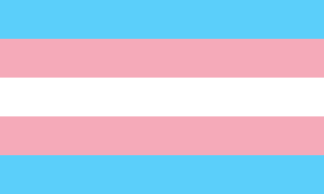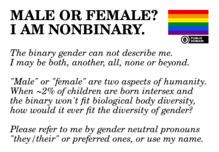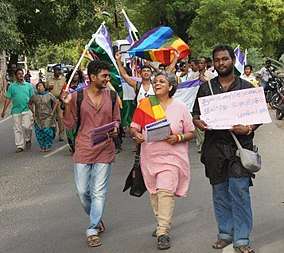Genderqueer
| Part of a series on |
| Transgender topics |
|---|
 |
|
Health care and medicine
|
|
Rights issues |
|
Society and culture |
|
By country
|
|
|
Genderqueer, also known as non-binary, is a catch-all category for gender identities that are not exclusively masculine or feminine—identities which are outside the gender binary and cisnormativity.[1] Genderqueer people may express a combination of masculinity and femininity, or neither, in their gender expression.
Genderqueer people may identify as either having an overlap of, or indefinite lines between, gender identity;[2] having two or more genders (being bigender, trigender, or pangender); having no gender (being agender, nongendered, genderless, genderfree or neutrois); moving between genders or having a fluctuating gender identity (genderfluid);[3] or being third gender or other-gendered, a category which includes those who do not place a name to their gender.[4]
Gender identity is separate from sexual or romantic orientation,[5] and genderqueer people have a variety of sexual orientations, just as transgender and cisgender people do.[6]
Definitions and identity
In addition to being an umbrella term, genderqueer has been used as an adjective to refer to any people who transgress distinctions of gender, regardless of their self-defined gender identity, or who "queer" gender. Individuals may express gender non-normatively by not conforming into the binary gender categories of "man" and "woman".[7] Genderqueer is often used to self-identify by people who challenge binary social constructions of gender.[8]
The term has also been applied by those describing what they see as a gender ambiguity.[9] Androgynous (also androgyne) is frequently used as a descriptive term for people in this category. This is because the term androgyny is closely associated with a blend of socially defined masculine and feminine traits.[10] However, not all genderqueer persons identify as androgynous. Some genderqueer people identify as a masculine woman or a feminine man or combine genderqueer with another gender option.[11]
Some references use the term transgender broadly, in such a way that it includes genderqueer/non-binary people.[12][13][14] The Human Rights Campaign Foundation and Gender Spectrum use the term gender-expansive to convey "a wider, more flexible range of gender identity and/or expression than typically associated with the binary gender system".[15]
A person who is genderfluid prefers to remain flexible about their gender identity rather than committing to a single gender.[16] They may fluctuate between genders or express multiple genders at the same time.[16][17]
An agender person ('a-' meaning "without"), also called genderless, genderfree, non-gendered, or ungendered,[18][19] is someone who identifies as having no gender or being without a gender identity.[20][21][22] Although this category includes a broad range of identities which do not conform to traditional gender norms, scholar Finn Enke states that people who identify with any of these positions may not necessarily self-identify as transgender.[23] Agender people have no specific set of pronouns; singular they is typically used, but it is not the default.[24] Neutrois and agender were two of 50 available custom genders on Facebook, which were added on 13 February 2014.[25] Agender is also available as a gender option on OkCupid since 17 November 2014.[26]
History
Anthropologists such as April Scarlett Callis believe that the traditional binary system of sexual identity can be traced to the 19th century when sexuality was first medicalized.[27] People started to identify as gay when biological sciences grew in influence, churches became less powerful, and social and political structure began to change.[27] George Chauncey, professor of history at Yale University, notes that during the early 20th-century gender roles rather than sexual partners were used to determine sexuality.[27] For instance, 'feminine" men who had sex with other men were labeled as "mollies" or "fairies", whereas masculine men who had sex with other men remained unlabeled.[27] The mid-20th century signaled the start of labeling individuals as either heterosexual or homosexual.[27]
Some genderqueer people[28][5] are medically treated for gender dysphoria with surgery and/or hormones as trans men and women are.
Gender neutrality
Gender neutrality is the movement to end discrimination of gender altogether in society through means of gender-neutral language, the end of sex segregation, and other means.
Pronouns and titles

Some genderqueer people prefer to use gender-neutral pronouns. Usage of singular 'they', 'their' and 'them' is the most common;[29] and ze, sie, hir, co, and ey are used as well. Some others prefer the conventional gender-specific pronouns 'her' or 'him', prefer to be referred to alternately as 'he' and 'she', or prefer to use only their name and not use pronouns at all.[30] Many genderqueer people prefer additional neutral language, such as the title 'Mx.' instead of Mr. or Ms.[31]
Legal recognition
In today's society, many genderqueer people still use the gender they were given at birth to conduct every day business because many areas of life still conduct business with binary genders. Things are changing though as more businesses are becoming more accepting of non-binary genders.[32] Multiple countries legally recognize non-binary or third gender classifications. Some non-western societies have long recognized transgender people as a third gender, though this may not (or may only recently)[33] include formal legal recognition. In western societies, Australia may have been the first country to legally recognize third classifications, following recognition of Alex MacFarlane as having indeterminate sex, reported in 2003.[34]
Discrimination
In the United States, the majority of respondents to the National Transgender Discrimination Survey chose "A gender not listed here." The 'Not Listed Here' respondents were nine percentage-points (33 percent) more likely to report forgoing healthcare due to fear of discrimination than the general sample (36 percent compared to 27 percent). 90 percent reported experiencing anti-trans bias at work, and 43 percent reported having attempted suicide.[35]
Symbols and observances

Many flags have been used in the genderqueer community to represent various identities. The genderqueer pride flag was designed in 2011. Lavender represents androgyny or simply queerness, white represents agender identity, and green represents those whose identities which are defined outside the binary.[38][39][40] Non-binary people have their own pride flag, created in 2014.[41] Yellow represents people whose gender exists outside the binary, purple is those who feel their gender is a mixture or between male and female, and the black represents people who feel as if they have no gender.[38] The white stripe represents those who embrace many or all genders.[42]
Genderfluid people, who also fall under the genderqueer umbrella, have their own flag as well. The pink stripe represents femininity, the white stripe represents lack of gender, the purple represents mixed gender or androgyny, the black represents all other genders, and the blue represents masculinity.[39][43]
Agender people, who also sometimes identify as genderqueer, have their own flag. This flag uses black and white stripes to represent an absence of gender, and a green stripe to represent non-binary genders.[44]
International Nonbinary Day is celebrated on 14 July.[45][46]
 Trans pride flag—the white stripe represents nonbinary (and intersex) people[47]
Trans pride flag—the white stripe represents nonbinary (and intersex) people[47] Agender pride flag
Agender pride flag Genderfluid pride flag
Genderfluid pride flag Genderqueer pride flag
Genderqueer pride flag Non-binary pride flag
Non-binary pride flag
See also
References
- ↑ Usher, Raven, ed. (2006). North American Lexicon of Transgender Terms. San Francisco. ISBN 978-1-879194-62-5. OCLC 184841392.
- ↑ Brill, Stephanie A.; Pepper, Rachel (28 June 2008). The Transgender Child: A Handbook for Families and Professionals. San Francisco: Cleis Press. ISBN 978-1-57344-318-0. OCLC 227570066.
- ↑ Winter, Claire Ruth (2010). Understanding Transgender Diversity: A Sensible Explanation of Sexual and Gender Identities. CreateSpace. ISBN 978-1-4563-1490-3. OCLC 703235508.
- ↑ Beemyn, Brett Genny (2008). "Genderqueer". glbtq: An Encyclopedia of Gay, Lesbian, Bisexual, Transgender, and Queer Culture. Chicago: glbtq, Inc. Archived from the original on 25 April 2012. Retrieved 3 May 2012.
- 1 2 "Transgender Glossary of Terms". GLAAD Media Reference Guide. Gay & Lesbian Alliance Against Defamation. Retrieved 25 May 2011.
- ↑ Stryker, Susan (2008). Transgender History. Berkeley: Seal Press. ISBN 978-1-58005-224-5. OCLC 183914566.
- ↑ Dahir, Mubarak (25 May 1999). "Whose Movement Is It?". The Advocate. Here Media. p. 52.
- ↑ Women's voices, feminist visions : classic and contemporary readings. Shaw, Susan M. (Susan Maxine), 1960-, Lee, Janet, 1954- (Sixth ed.). New York, NY. ISBN 9780078027000. OCLC 862041473.
- ↑ Girshick, Lori B. (2008). Transgender Voices: Beyond Women and Men. Hanover: University Press of New England. ISBN 978-1-58465-645-6. OCLC 183162406.
- ↑ Shaw, Susan M.; Lee, Janet (2015). Women's Voices, Feminist Visions (6 ed.). New York, NY: McGraw-Hill Education.
- ↑ Walsh, Reuben (December 2010). "More T, vicar? My experiences as a genderqueer person of faith". All God's Children. Vol. 2 no. 3. Lesbian and Gay Christian Movement.
- ↑ Johanna Schorn. "Taking the "Sex" out of Transsexual: Representations of Trans Identities in Popular Media" (PDF). Inter-Disciplinary.Net. Universität zu Köln. p. 1. Archived from the original (PDF) on 25 October 2014. Retrieved 23 October 2014.
The term transgender is an umbrella term "and generally refers to any and all kinds of variation from gender norms and expectations" (Stryker 19). Most often, the term transgender is used for someone who feels that the sex assigned to them at birth does not reflect their own gender identity. They may identify as the gender ‘opposite’ to their assigned gender, or they may feel that their gender identity is fluid, or they may reject all gender categorizations and identify as agender or genderqueer.
- ↑ Marc E. Vargo (30 November 2011). "A Review of " Please select your gender: From the invention of hysteria to the democratizing of transgenderism "" (PDF). Journal of GLBT Family Studies. New York/London: Routledge. 7 (5): 2 (493). doi:10.1080/1550428X.2011.623982. ISSN 1550-4298. Retrieved 23 October 2014.
up to three million U. S. citizens regard themselves as transgender, a term referring to those whose gender identities are at odds with their biological sex. The term is an expansive one, however, and may apply to other individuals as well, from the person whose behavior purposely and dramatically diverges from society's traditional male/female roles to the "agender", "bigender" or "third gender" person whose self-definition lies outside of the male/female binary altogether. In short, those counted under this term constitute a wide array of people who do not conform to, and may actively challenge, conventional gender norms.
- ↑ Kirstin Cronn-Mills (2014). "IV. Trans*spectrum. Identities". Transgender Lives: Complex Stories, Complex Voices. Twenty-First Century Books. p. 24. ISBN 978-1-4677-4796-7. Retrieved 23 October 2014.
Many different individuals fall under what experts call the trans* spectrum, or the trans* umbrella."I'm trans*" and "I'm transgender" are ways these individuals might refer to themselves. But there are distinctions among different trans* identities. […] Androgynous individuals may not identify with either side of the gender binary. Other individuals consider themselves agender, and they may feel they have no gender at all.
- ↑ Human Rights Campaign Foundation and Gender Spectrum, Supporting and Caring for our Gender-Expansive Youth, accessed 21 January 2016
- 1 2 Cronn-Mills, Kirstin (2015). Transgender Lives: Complex Stories, Complex Voices. Minneapolis: Twenty-First Century Books. p. 24. ISBN 0-7613-9022-7.
- ↑ McGuire, Peter (9 November 2015). "Beyond the binary: what does it mean to be genderfluid?". The Irish Times. Retrieved 1 December 2015.
- ↑ "LGBTQ Needs Assessment" (PDF). Encompass Network. April 2013. pp. 52–53. Archived from the original (PDF) on 24 October 2014. Retrieved 18 October 2014.
- ↑ "Gender alphabet" (PDF). Safe Homes. p. 1. Retrieved 18 October 2014.
- ↑ Vargo, Marc E. (2011). "A Review of "Please select your gender: From the invention of hysteria to the democratizing of transgenderism"". Journal of GLBT Family Studies. 7 (5): 493–494. doi:10.1080/1550428x.2011.623982.
- ↑ Cronn-Mills, Kirstin (1 September 2014). Transgender Lives: Complex Stories, Complex Voices. Twenty-First Century Books. ISBN 978-1-4677-4796-7.
- ↑ Schorn, Johanna (22 February 2016). "Taking the "Sex" out of Transsexual: Representations of Trans Identities in Popular Media".
- ↑ Anne Enke, ed. (2012). "Note on terms and concepts". Transfeminist Perspectives In and Beyond Transgender and Gender Studies. Temple University Press. pp. 16–20, see pp. 18–9. ISBN 978-1-4399-0748-1.
- ↑ Sojwal, Senti (16 September 2015). "What Does "Agender" Mean? 6 Things To Know About People With Non-Binary Identities". Bustle. Retrieved 22 February 2016.
- ↑ Facebook sex changes: which one of 50 genders are you?. The Daily Telegraph. 14 February 2014.
- ↑ "OkCupid expands gender and sexuality options". PBS NewsHour. 17 November 2014. Retrieved 18 November 2014.
- 1 2 3 4 5 Callis, April Scarlette (2014-02-05). "Bisexual, pansexual, queer: Non-binary identities and the sexual borderlands". Sexualities. 17 (1–2): 63–80. doi:10.1177/1363460713511094.
- ↑ "Transgender (adj.)". Stylebook Supplement on LGBT Terminology. National Lesbian and Gay Journalists Association. Archived from the original on 8 April 2011. Retrieved 25 May 2011.
- ↑ "NB/GQ Survey 2017 - the worldwide results". Gender Census. Retrieved 14 July 2018.
- ↑ Feinberg, Leslie (1996). Transgender Warriors: Making History from Joan of Arc to Dennis Rodman. Boston: Beacon Press. ISBN 978-0-8070-7940-9. OCLC 33014093.
- ↑ Ruth Pearce (21 July 2011). "Non-gendered titles see increased recognition". Lesbilicious. Retrieved 29 August 2012.
- ↑ Richards, Christina; Bouman, Walter Pierre; Seal, Leighton; Barker, Meg John; Nieder, Timo O.; T'Sjoen, Guy (2016). "Non-binary or genderqueer genders". International Review of Psychiatry. 28 (1): 95–102. doi:10.3109/09540261.2015.1106446. PMID 26753630 – via EBSCOhost.
- ↑ "Pakistani eunuchs to have distinct gender". BBC News. December 23, 2009. Retrieved 2009-12-23.
- ↑ "Newsletter of the Sociology of Sexualities Section of the American Sociological Association" (PDF). American Sociological Association Sexualities News. 6 (1). Summer 2003.
- ↑ Harrison, Jack; Grant, Jaime; Herman, Jody L. "A Gender Not Listed Here: Genderqueers, Gender Rebels, and OtherWise in the National Transgender Discrimination Survey" (PDF). Archived from the original (PDF) on 25 July 2012. Retrieved 29 April 2013.
- ↑ "One Who Fights For an Other". The New Indian Express.
- ↑ "Worldwide gay rights as a social movement picks up". merinews.com. Retrieved 2017-05-12.
- 1 2 "He, She or They? » The Commuter". ncccommuter.org. Retrieved 2016-12-20.
- 1 2 "Flags and Symbols" (PDF). www.amherst.edu. Amherst. Retrieved December 20, 2016.
- ↑ "Gender and Sexuality Awareness Flags". David Mariner. 2015-10-26. Retrieved 2016-12-20.
- ↑ "8 Things Non-Binary People Need to Know". Let's Queer Things Up!. 2015-03-15. Retrieved 2016-12-20.
- ↑ "Pride Flags Colors explained!". DeviantArt. Retrieved 2017-11-15.
- ↑ "Gender-fluid added to the Oxford English Dictionary". LGBTQ Nation. Retrieved 2016-12-20.
- ↑ Manzella, Samantha (2017-10-07). "Beyond The Rainbow: Your Guide To LGBT Flags". NewNowNext. Retrieved 2018-06-25.
- ↑ Mathers, Charlie. "Prepare for International Non-binary Day by learning how to be a better ally". Gay Star News. Retrieved 14 July 2018.
- ↑ Hirst, Jordan. "Inclusive Brisbane Party To Mark International Non-Binary Day". QNEWS Magazine. Retrieved 14 July 2018.
- ↑ Sankin, Aaron (2012-11-20). "Transgender Flag Flies In San Francisco's Castro District After Outrage From Activists". Huffington Post. Retrieved 2018-07-08.
Further reading
- Bernstein Sycamore, Mattilda, ed. (2006). Nobody Passes: Rejecting the Rules of Gender and Conformity. Emeryville: Seal Press. ISBN 978-1-58005-184-2. OCLC 50389309.
- Bornstein, Kate; Bergman, S. Bear, eds. (2010). Gender Outlaws: The Next Generation (Reprint ed.). Berkeley: Seal Press. ISBN 978-1-58005-308-2. OCLC 837948378.
- Fine, Cordelia (2011). Delusions of Gender: How Our Minds, Society, and Neurosexism Create Difference (Reprint ed.). New York: W. W. Norton & Company. ISBN 978-0-393-34024-2. OCLC 449865367.
- Fineman, Martha Albertson (2013). "Feminism, masculinities, and multiple identities". Nevada Law Journal, special issue: Men, Masculinities, and Law: A Symposium on Multidimensional Masculinities Theory. William S. Boyd School of Law. 13 (2): 16.
- Hines, Melissa (2005). Brain Gender. Oxford University Press. ISBN 978-0-19-518836-3. OCLC 846105995.
- Nestle, Joan; Howell, Clare; Wilchins, Riki Anne, eds. (2002). GenderQueer: Voices from Beyond the Sexual Binary. Los Angeles: Alyson Books. ISBN 978-1-55583-730-3. OCLC 50389309.
- Peterson, Tim Trace; Tolbert, T. C., eds. (2013). Troubling the Line: Trans and Genderqueer Poetry and Poetics. Callicoon: Nightboat Books. ISBN 978-1-937658-10-6. OCLC 839307399.
- Richards, C., Bouman, W. P., & Barker, M.-J. (2017). Genderqueer and non-binary genders. London: Palgrave Macmillan. ISBN 9781137510525. OCLC1021393997.
- Scout, Ph.D. (23 July 2013). "(A) Male, (B) Female, (C) Both, (D) Neither". The Huffington Post. AOL. Retrieved 2 August 2013.
- Stryker, Susan; Whittle, Stephen, eds. (2006). The Transgender Studies Reader. New York: Routledge. ISBN 978-1-58005-184-2. OCLC 50389309.
